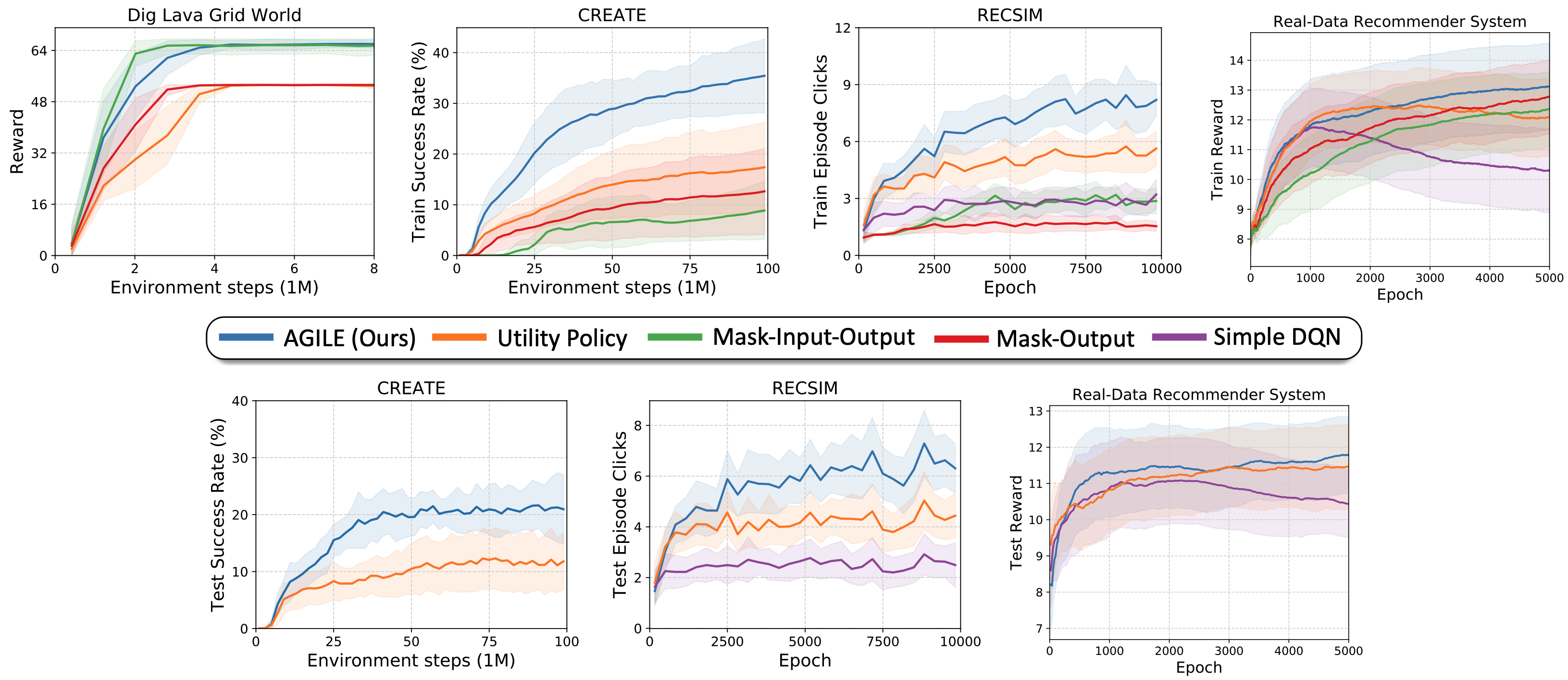Ayush Jain*1 Norio Kosaka*2 Kyung-Min Kim2 4 Joseph J. Lim3†4‡
1CLVR Lab, University of Southern California (USC) 2NAVER CLOVA
3Korea Advanced Institute of Science and Technology (KAIST) 4NAVER AI Lab
†Work done while at USC ‡NAVER AI Advisor
This is the official PyTorch implementation of the paper "Know Your Action Set: Learning Action Relations for Reinforcement Learning" (ICLR 2022).
Intelligent agents adapt task solutions based on how the given actions relate to each other.
(Left) Since a hammer is available, the agent starts by choosing the nail to place on the wall.
(Right) The nail is no longer a useful tool without a hammer, so using an adhesive tape is better since a hook is provided.
Given an action set, AGILE builds a complete action graph by joining action representations and state encoding. A graph attention network learns to attend to other actions that are relevant for each action in the current state. For example, the attention weight is expected to be high between the cannon and the fire because fire can activate the cannon. The output relational action features are better suited for decision-making via a utility network that computes the value or selection prob- ability of the action. This utility network also takes as input the state and mean-pooled vector of the relational action features.
The structure of the repository:
data: Scripts used for analysis figures and experiments.gnn: Implementation of Action Graph.value_based: Implementation of Value-based methods for Recommender Systems.policy_based: Implementation of Policy gradient methods for CREATE / Gridworld environments.main_value_based.py: Entry point for running value-based methods.main_policy_based.py: Entry point for policy gradient methods.
- Python: 3.6 or more is required (Recommended Python 3.6.9)
- All the python package requirements are in
requirements.txt. Install them in a new virtual environment (e.g. pyenv, conda) via:pip install -r requirements.txt
-
General Notes
- Set Environment Name as:
- Dig Lava Grid World:
$ENV_NAME='MiniGrid-DualLavaEnv-v0' - CREATE:
$ENV_NAME='CreateLevelPush-v0'
- Dig Lava Grid World:
- To run without multi-threading and CUDA (e.g. on mac OS), add arguments:
--num_processes 1 --eval_num_processes 1 --no_cuda True - To fit a run on your GPU, reduce
--num_processesfrom its default value of 64 (Grid World) or 48 (CREATE). - Videos are generated in policy_based/data/vids.
- Set Environment Name as:
-
Baseline Agents
-
AGILE
python main_policy_based.py --env_name=$ENV_NAME --prefix=agile --method_name=relational -
Utility Policy
python main_policy_based.py --env_name=$ENV_NAME --prefix=utility_policy --method_name=baseline -
Mask-Input-Output
python main_policy_based.py --env_name=$ENV_NAME --prefix=mask_input_output --method_name=input_mask -
Mask-Output
python main_policy_based.py --env_name=$ENV_NAME --prefix=mask_output --method_name=mask
-
-
Ablation Agents
-
Summary-GAT
python main_policy_based.py --env_name=$ENV_NAME --prefix=summary_gat --method_name=summary --action_summarizer=gnn -
Summary-LSTM
python main_policy_based.py --env_name=$ENV_NAME --prefix=summary_lstm --method_name=summary --action_summarizer=lstm -
Summary-Deep Set
python main_policy_based.py --env_name=$ENV_NAME --prefix=summary_deep_set --method_name=summary --action_summarizer=deep_set
-
-
Analysis Agents
-
AGILE-GCN
python main_policy_based.py --env_name=$ENV_NAME --prefix=agile_gcn --method_name=relational --gnn_gat_model=gcn2 -
AGILE-Only Action
python main_policy_based.py --env_name=$ENV_NAME --prefix=agile_only_action --method_name=relational --summarizer_use_only_action=True
-
-
Train policy directly with:
python main_value_based.py -
Baseline Agents
-
AGILE
python main_value_based.py --if_e_node=True --agent_standardRL_type=None --action_summarizer=gnn --graph_type=gat2 --gcdqn_no_graph=False --summarizer_use_only_action=False
-
Utility Policy(CDQN)
python main_value_based.py --if_e_node=False --agent_standardRL_type=None --action_summarizer=None --graph_type=None --gcdqn_no_graph=True --summarizer_use_only_action=False
-
Mask-Input-Output
python main_value_based.py --if_e_node=False --agent_standardRL_type=1 --action_summarizer=None --graph_type=None --gcdqn_no_graph=True --summarizer_use_only_action=False
-
Mask-Output
python main_value_based.py --if_e_node=False --agent_standardRL_type=2 --action_summarizer=None --graph_type=None --gcdqn_no_graph=True --summarizer_use_only_action=False
-
Simple DQN
python main_value_based.py --agent_type=dqn --env_name=recsim
-
-
Ablation Agents
-
Summary-GAT
python main_value_based.py --if_e_node=False --agent_standardRL_type=None --action_summarizer=gnn --graph_type=gat2 --gcdqn_no_graph=False --summarizer_use_only_action=False
-
Summary-LSTM
python main_value_based.py --if_e_node=False --agent_standardRL_type=None --action_summarizer=lstm --graph_type=None --gcdqn_no_graph=False --summarizer_use_only_action=False --gcdqn_use_post_summarise_mlp=False
-
Summary-DeepSet
python main_value_based.py --if_e_node=False --agent_standardRL_type=None --action_summarizer=deep_set --graph_type=None --gcdqn_no_graph=False --summarizer_use_only_action=False --gcdqn_use_post_summarise_mlp=False
-
-
Analysis Agents
-
AGILE-GCN
python main_value_based.py --if_e_node=True --agent_standardRL_type=None --action_summarizer=gnn --graph_type=gcn --gcdqn_no_graph=False --summarizer_use_only_action=False
-
AGILE-Only Action
python main_value_based.py --if_e_node=True --agent_standardRL_type=None --action_summarizer=gnn --graph_type=gat2 --gcdqn_no_graph=False --summarizer_use_only_action=True
-
-
Some important parameters
-
Agent
--agent_type=random/dqn/cdqn/gcdqn-> change the agent to train--graph_type=gat2/gcn-> change the underlying GNN--action_summarizer=gnn/lstm/deepSet-> select a method for Action Graph to summarize the actions--graph_aggregation_type=mean/sum-> select how to aggregate the node-features in Action Graph--if_e_node=True/False-> AGILE or Summary variants
-
Env (Experiments done on default values. The following is for reference only.)
--num_candidates=20-> Size of the candidate set of items--recsim_type_reward=click/cpr_score etc-> change the reward type--recsim_reward_characteristic=None/shannon_entropy etc-> change the behaviour of user choice model--recsim_resampling_method=random/skewed etc-> change the sampling method of candidate-set construction
-
By the following procedure, you can generate the dataset to play with the real-world recommender systems The difference between this synthetic dataset and the real dataset is whether artificial or not. Otherwise, we used the same environment implementation for the experiments.
-
Run
./data/sample/generate_fake.pyto generate the fake datacd ./data/samplepython generate_fake.py
-
(** From the root directory)Train the VAE to produce the item embedding
python value_based/train_embedding.py --env_name=sample --save_dir=./trained_weight/reward_model/sample --data_dir=./data/sample
-
Train the reward model
-
Offline Reward Model
python value_based/train_rewardModel.py --env_name=sample --obs_encoder_type=sequential-rnn --save_dir=./trained_weight/reward_model/sample --data_dir=./data/sample --item_embedding_path=./trained_weight/reward_model/sample/vae_item_embedding.npy --user_embedding_path=./data/sample/user_attr.npy --rm_if_train_simulator=True --rm_offline_or_online=offline
-
Online Reward Model
python value_based/train_rewardModel.py --env_name=sample --obs_encoder_type=sequential-rnn --save_dir=./trained_weight/reward_model/sample --data_dir=./data/sample --item_embedding_path=./trained_weight/reward_model/sample/vae_item_embedding.npy --user_embedding_path=./data/sample/user_attr.npy --rm_if_train_simulator=True --rm_offline_or_online=online
-
In
./trained_weight/sample/reward_model, Rename the suitable offline/online reward models tooffline.pklandonline.pklto use for RL training. -
Train a policy
You can use the commands in RecSim to train all the agents!python main_value_based.py --env_name=sample --obs_encoder_type=sequential-rnn --data_dir=./data/sample/ --item_embedding_type=pretrained --user_embedding_type=pretrained --item_embedding_path=./trained_weight/reward_model/sample/vae_item_embedding.npy --user_embedding_path=./data/sample/user_attr.npy --data_category_cols=genre/size --rm_weight_save_dir=./trained_weight/reward_model/sample --recsim_if_mdp=False
- PPO code is based on the Pytorch implementation of PPO by Ilya Kostrikov.
- Utility Network and CREATE environment code is based on CLVR Lab's Generalization to new actions in RL implementation
- VAE code is based on https://github.com/AntixK/PyTorch-VAE/blob/master
- GCN code is based on https://github.com/pyg-team/pytorch_geometric
- GAT code is based on https://github.com/Diego999/pyGAT
- The Grid world environment is adapted from https://github.com/maximecb/gym-minigrid
- RecSim Simulator: https://github.com/google-research/recsim
If you find this work useful in your research, please consider citing:
@inproceedings{
jain2022know,
title={Know Your Action Set: Learning Action Relations for Reinforcement Learning},
author={Ayush Jain and Norio Kosaka and Kyung-Min Kim and Joseph J Lim},
booktitle={International Conference on Learning Representations},
year={2022},
url={https://openreview.net/forum?id=MljXVdp4A3N}
}


